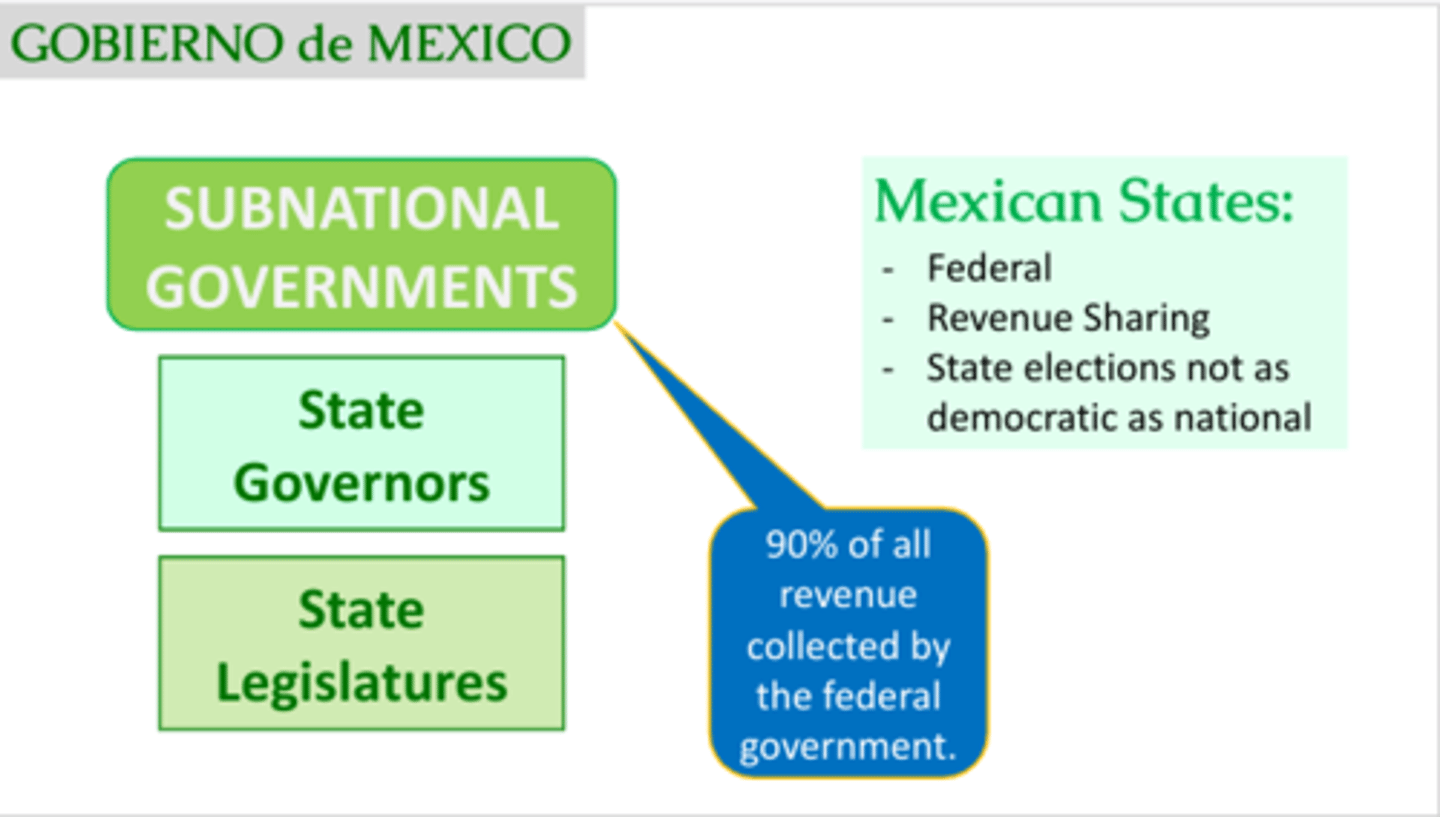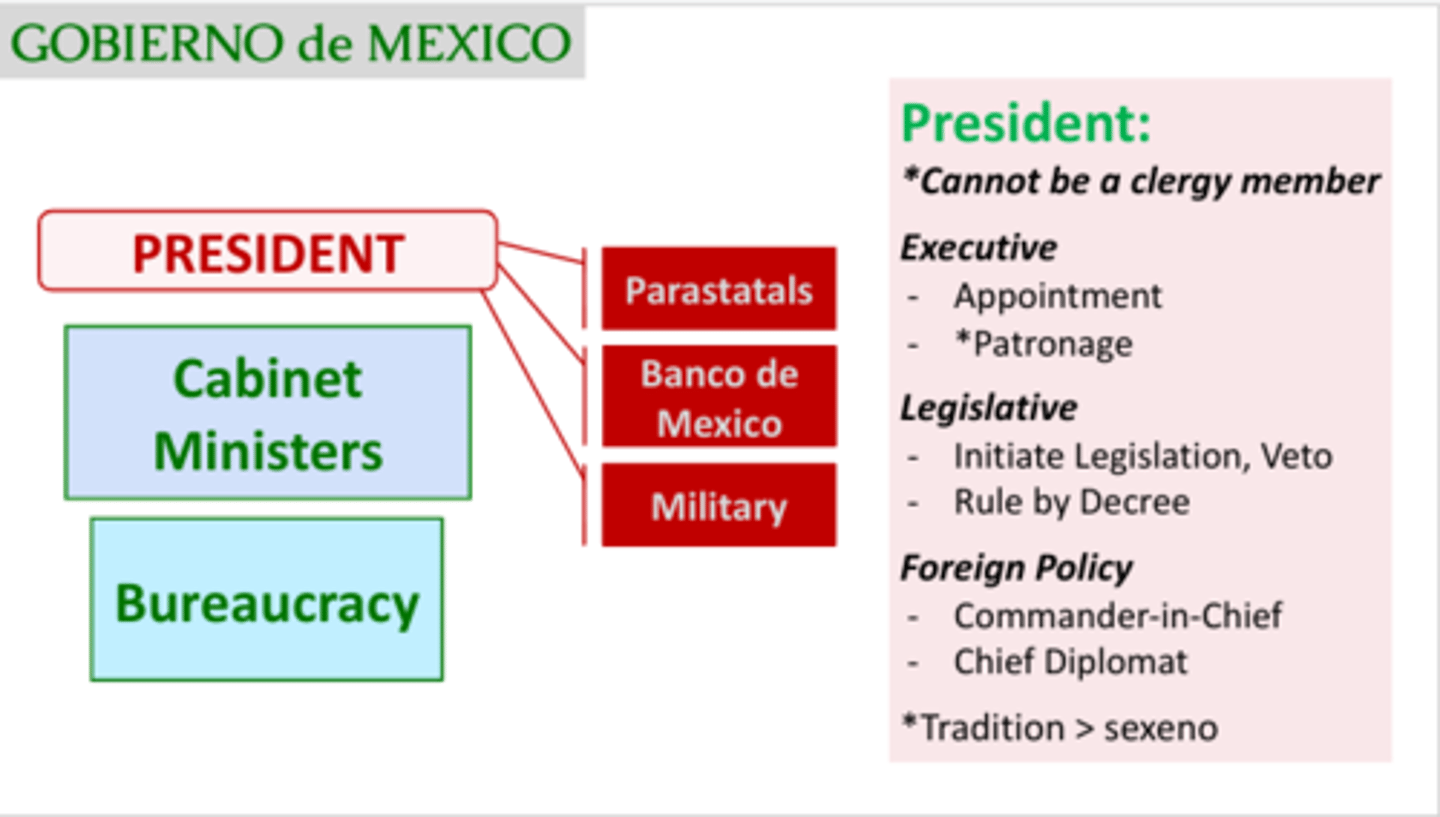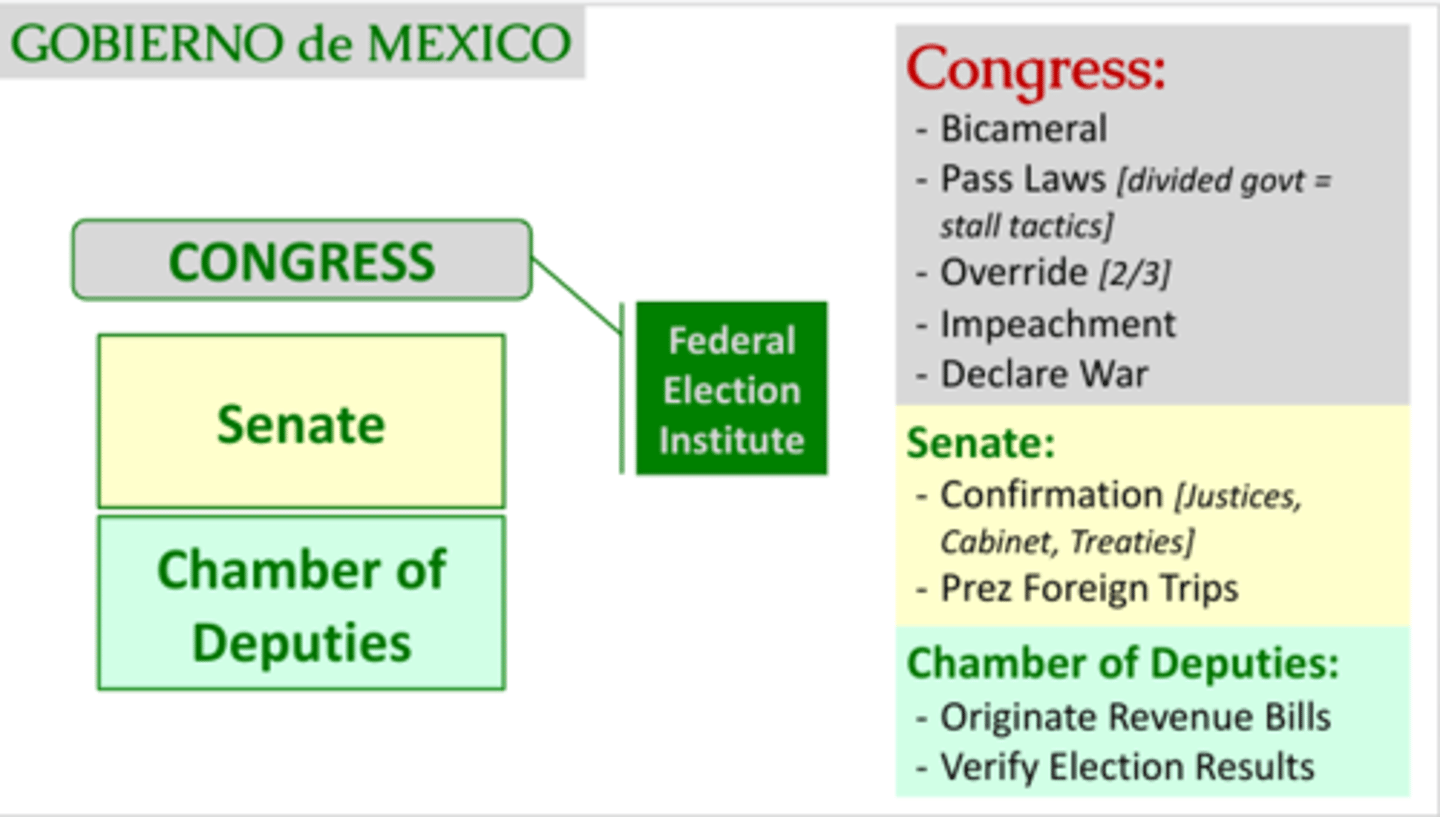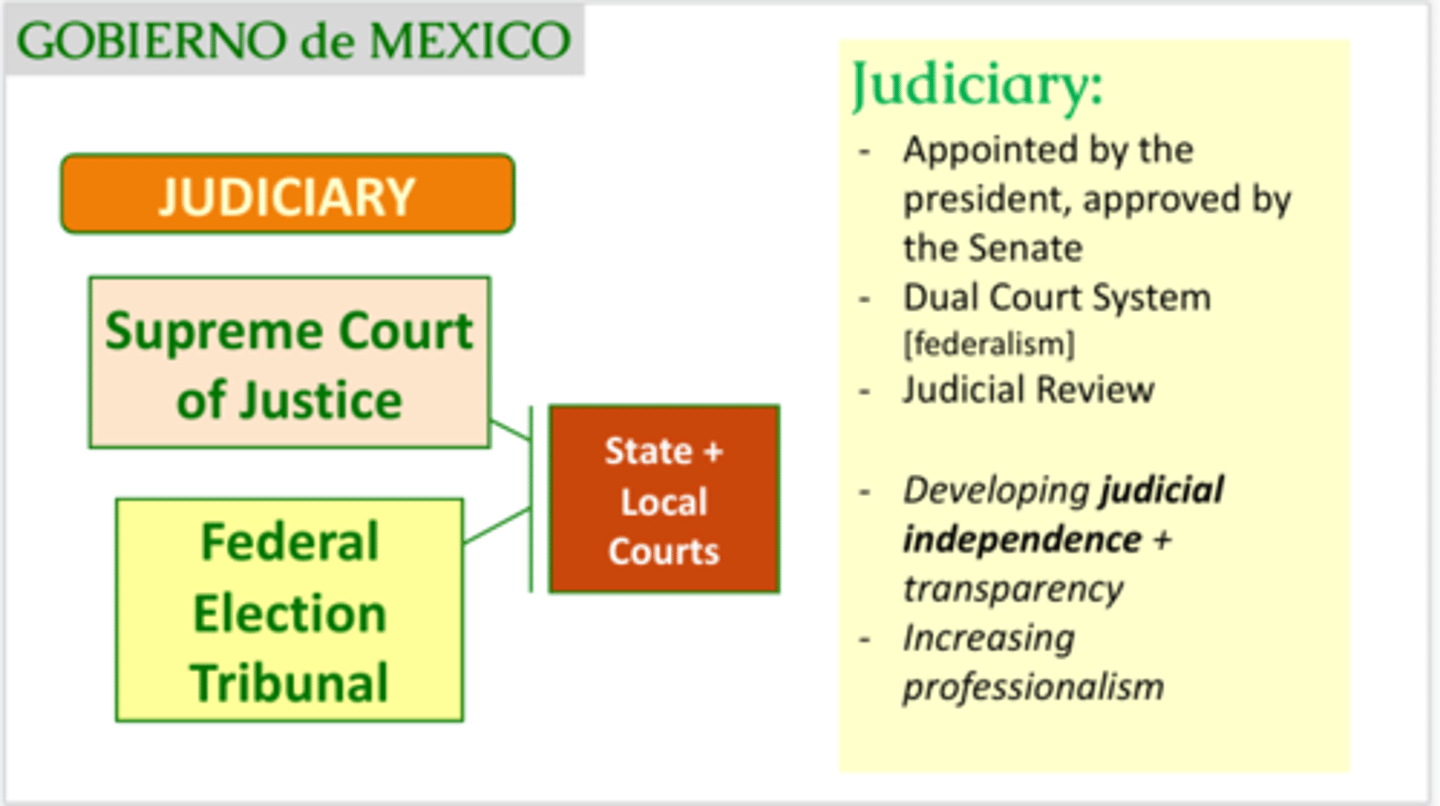AP Comp Gov Unit 2A: Mexico
1/30
There's no tags or description
Looks like no tags are added yet.
Name | Mastery | Learn | Test | Matching | Spaced |
|---|
No study sessions yet.
31 Terms
Federal Republic
Direct elections, presidential, three branches, separation of powers, federal (states)
Direct Elections
a system of choosing political officeholders in which the voters directly cast ballots for the person, persons, or political party that they desire to see elected
Presidential
a system of government in which the legislative and executive branches operate independently of each other
Three Branches
Legislative, Executive, Judicial
Federal (states)
states whose power is divided between the central state and regional or local authorities (such as states, provinces, counties, and cities)
-32 Mexican states and 1 federal district (Mexico City)
-States are constitutionally protected
-Revenue sharing (states depend heavily on national government for money; 90% of revenue is collected by the government
-State elections are not as democratic as national (national=more free and competitive than states)

Democratization and its impact on power, authority, and legitimacy
Political violence to single party rule to multiparty democracy, elections, citizen participation, universal suffrage, developing rule of law, ethnic violence and separatism
Political violence to Single Party Rule to Multiparty Democracy
Spanish Colonialism
-Ruled for 300+ years
-Mercantilist->extract natural resources (exploit to make money)
-Haciendas (cash crops, large farms/plantations, mines, factories)
-Social hierarchy with Spanish at the top, then Mestizos (mix of Spanish and indigenous), and Native Mexicans at the bottom (Native Mexicans dominate the people in poverty--hierarchy has lasting impacts)
-Catholicism (Catholic Church still is a significant power in politics)
Independence
-Struggle against the Spanish=violent
-100+ years of caudillo (strongman) rule=history of authoritarianism
-Haciendas and foreign ownership remained
-Loss of territory (cough, USA, cough)
-Establishment of sexeño and non-reelection
1910 Revolution
-Spark=Diaz's dictatorship/policies/election tampering
-Diaz arrested opposition leader, Madero
-Diaz ousted, but six+ more years of violence, executions, and a coup
-Led to a Constitution of 1917
-1910 revolution leads to civil war
-All rebels agreed on ousting Diaz out, but on nothing else
-Truce leads to Constitution
1917 Constitution
-Reflection of the past: presidential sexeno, non-reelection, no foreign ownership, limitations on the Catholic Church, land reform, foreigners can only lease land, etc.
-But violence continued until the PRI founded=single party dominant system, but stability and predictability
-PRI dominated from 1933 -2000
-Was a dictatorship due to single-party dominance, but there was much less violence
-Today there are 4 main Mexican Political Parties: PRI, PRD, PAN, and Morena (Morena has today's president, Andres Manuel Lopez Obrador--AMLO)
Elections
A formal and organised choice by vote of a person for a political office or other position
-Happens every 6 years for both President and Senate; Senators may run for a consecutive term; president=no reelection
-Chamber of Deputies=3 years; Deputies may serve up to four consecutive terms.
Citizen Participation
Mexican citizens can vote and join civil society groups
Universal Suffrage
voting rights for all adult citizens
Developing Rule of Law
Mexico is trying to apply rule of law to everyone, but things such as patronage and corruption still exist
Ethnic Violence and Separatism
-Native Mexicans make up the majority of Mexicans living in poverty
-Spaniards created hierarchy that put the Spanish on top, then Mestizos (people of mixed Spanish and indigenous ethnicity), then finally native Mexicans
Accommodation
-Accommodation was a direct result of Mexico's political history
-Accommodation: government officials and interest groups work together to protect the growth of commerce, finance, industry and agriculture and resolve points of contention
Why is this important? Government stability.
-Accommodation=way to resolve political tensions; prevent serious conflict; solution-oriented; pragmatic
Executive
President, cabinet, appointment/removal, term limit ("sexeno"), single executive, veto, foreign policy chief, commander-in-chief

President
Head of the Executive Branch
Cabinet/Appointment/Removal
-Presidential appointive power=allows him to decide how policy is implemented since appointive power extends to the whole state
-Under PRI, the most important positions in cabinet and bureaucracy were filled either from the president's personal camarilla (a group of unofficial often secret and scheming advisors) or from a small group of other politicians who had president's trust; others were chosen more on their personal connections
-Patronage and personal connections=major part of appointment (president rewards his supporters or their family members government offices)
-Appoint and remove freely the Secretaries of State, remove the ambassadors, consuls general and senior employees of the Treasury, appoint and remove freely all other employees of the Union whose appointment or removal is not otherwise in the Constitution or in laws;
-Appoint, with Senate approval, ambassadors, consuls general, superior employees of the Treasury and members of collegial bodies of regulation in telecommunications, energy and economic competition;
-Appoint, with the approval of the Senate, the colonels and general and flag officers of the Army, Navy and Air Force
-It used to be tradition for everyone to resign when new president came; since Mexico became more democratic in 2000 it has been changing
-can freely remove appointees
Term limit ("Sexeno")
President can only serve one 6-year term; no re-elections
Single Executive
An executive branch led by a single person.
Veto
Chief executive's power to reject a bill passed by a legislature
Foreign Policy Chief and Commander in Chief
Commander-in-Chief, Chief Diplomat
-Senate confirms treaties and approves presidential foreign trips (Mexico has a history of executives fleeing the country; this was to ensure this wouldn't happen again)
What are the advantages and disadvantages of the sexeno?
Pros: introduce new ideas, eliminates bad officials, no accumulation of power; helps to consolidate democracy, increases likelihood of alternation of power
Cons: no long-term vision or plans, lose experience and/or quality officials, reduces accountability to constituents and increases loyalty to party
Legislature
Bicameral, approve legislation, Chamber of Deputies: levies taxes and verifies outcomes of elections, Senate=confirm presidential appointments to the Supreme Court, approve treaties and federal intervention in state matters

Bicameral, approve legislation
-Coequal chambers in Congress
-Upper House=Senate
-Lower House=Chamber of Deputies
-Pass laws (divided government=stall tactics)
-Override (2/3)
-Impeachment (Deputies=brings impeachment charges, Senate=jury) (just like the US)
-Declare War
Chamber of Deputies
-Levies taxes
-Verifies Election Results; there is no Vice President (so when the Mexican President dies, Congress just picks another) (this is different in the US where the Senate confirms president election and House confirms VP)
-Originates Revenue Bills
-300 elected by SMDPs, the rest are elected by proportional representation
Senate
-Confirms presidential appointments to the Supreme Court, approve treaties and federal intervention in state matters
-Confirms justices, cabinet, treaties
-Approves Presidential Foreign Trips
-3 per each state (2 for majority party then 1 for largest minority party) then 32 other seats go in proportion to the votes each party received at the national level
Judiciary
Developing independence, judicial review, federal, Supreme Court judges nominated by President/approved by Senate, 15 year term

Developing independence (and transparency)
While significant advances have been made in judicial independence, improving the professionalism of the judiciary and strengthening institutions, very little has changed for those who have the most first-hand interaction with the courts: accused offenders and litigants
-Under PRI=not independent judiciary
-becoming more independent (more able to check exec/legislative's power and protect people's rights) due to growing use of judicial review
Judicial Review
In Mexico, the amparo proceeding or "juicio de amparo" is used to declare laws and acts of authority unconstitutional. In the United States, this principle is called "judicial review" and is frequently described as the power of judges to declare laws unconstitutional
-Under PRI=not independent judiciary
Supreme Court Judges are...
appointed by president, approved by the Senate
-also have a 15 year term
-judges used to resign when there was a new president, but now that the court is more independent this is not as common
-increasing in professionalism
Dual Court System
Mexico has both federal and state courts
Mexican Corporatism
Another term to describe the way people are integrated into the system via patron-client relations. (there is some certainty that Mexico won't return to corporatist, camarilla [In Mexico and elsewhere in Latin America, a politician's personal following in a patron-client relationship] based PRI dominance)